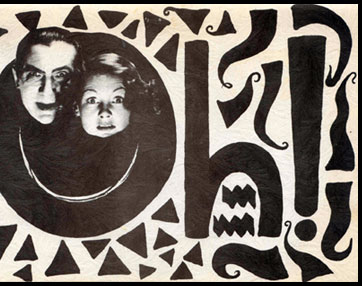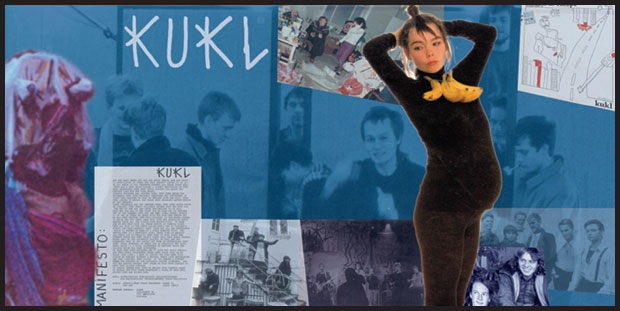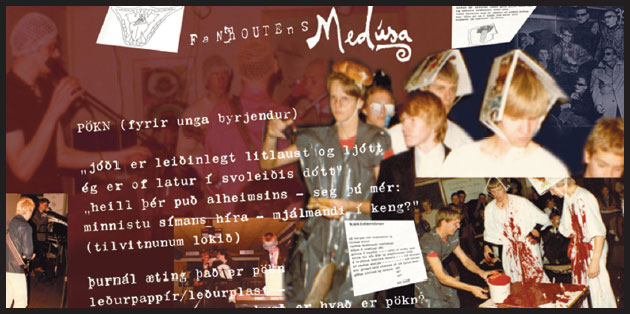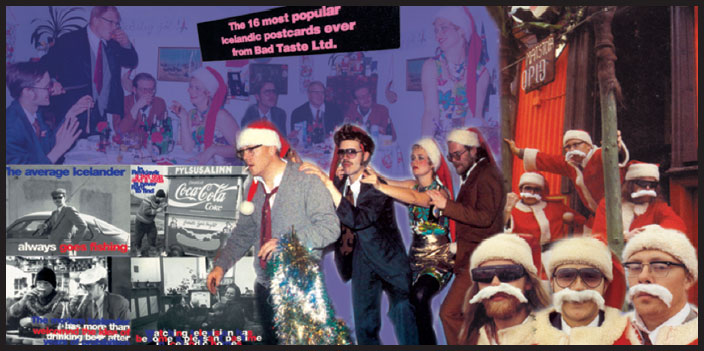Ólafur J. Engilbertsson
 To a large extent the roots of Bad Taste lie in the final broadcast of legendary radio show Áfangar (Stages). The show’s hosts, Ásmundur Jónsson and Gudni Rúnar Agnarsson, had run a veritable night school in progressive music on the Icelandic State Radio from 1975 to 1983, introducing everything from Wild Man Fisher to Morrissey. For their final show in July 1983, they put together a “super group” of musicians who they felt represented the most interesting elements of the wave of music which had washed over Iceland’s from the beginning of the ‘80s.
To a large extent the roots of Bad Taste lie in the final broadcast of legendary radio show Áfangar (Stages). The show’s hosts, Ásmundur Jónsson and Gudni Rúnar Agnarsson, had run a veritable night school in progressive music on the Icelandic State Radio from 1975 to 1983, introducing everything from Wild Man Fisher to Morrissey. For their final show in July 1983, they put together a “super group” of musicians who they felt represented the most interesting elements of the wave of music which had washed over Iceland’s from the beginning of the ‘80s.
The chosen ones were Björk Gudmundsdóttir from the band Tappi Tíkarrass; Einar Örn Benediktsson from Purrkur Pillnikk, Gudlaugur Óttarsson and Sigtryggur Baldursson from Theyr, Birgir Mogensen from Killing Joke, and Einar Melax and Thór Eldon from Fan Houtens Kókó and the surrealist group Medúsa. (When the broadcast happened Thór was actually away on a trip through France and Spain, and consequently did not become a part of the band that came into being afterward.) As the radio performance was meant to be a one off, the group was nameless to begin with, but soon afterwards the decision was made to continue the project – and the band was named Kukl.
In its three years of activity, Kukl put out the single “Söngull” and two LPs, “The Eye” and “Holidays in Europe,” which also went under the name “The Naughty Nought.”
The band performed throughout Europe to positive reception, but the music was considered dark, complicated and hard to digest. The individuals who formed Kukl had more in common than the wish to write and play innovative music, and most of them were connected with cultural activities outside the music scene. So, the group played literature, art, theatre, filmmaking and the media like so many instruments, yet the collective goal was to create a base for self-sufficient culture that would thrive without the support of state or mass media. This base later became Bad Taste.

In March 1985 Sjón gave a speech on the difference between the so called “photocopy poets” and traditionally published poets at a language conference that literature students at the University of Iceland. There he claimed that poetry had found a new home, away from the publishing houses, and in the underworld of cheaply made books sold on the streets and in the cafés of Reykjavík. The copy centre Letur was the hangout of the photocopy poets. They arrived with their proofs, in various states of readiness for print, yet always received first-class service for very reasonable rates from Sigurjón Thorbergsson and his staff. When Letur was forced to cease operations in 1983 it had been active for about a decade and had put out many classic works.
The music scene was thriving and the first independent labels were set up in 1981. With the arrival of the small pressing plant Alfa in the town of Hafnarfjördur it became child’s play to mass produce recorded material without involving the record companies – and by keeping recording costs at rock bottom the Studio Mjöt did a lot to encourage the recording of material that the respectable record companies didn’t want to touch.
The most active and productive of the indie labels was Gramm, the home of Purrkur Pillnikk. It was run by Ásmundur Jónsson and Einar Örn, together with Dóra Jónsdóttir and Björn Valdimarsson, and most of the future Sugarcubes worked there at some point. Its record store in an alley off the main shopping street, Laugavegur in downtown Reykjavík, became the refuge for those who put out copied material at their own cost, whether it was books, cassettes, or records in small runs. Yes, it was punk and poetry. Thór Eldon, Sjón, Einar Melax, Ólafur Engilbertsson and Jóhamar were all in the Medúsa group that put out photocopied poetry books and cassettes, 29 titles in all, from 1979 to 1986. Bragi Ólafsson and Einar Örn were in Purrkur Pillnikk, who not only put out their own 7-inch in 1981, but also published poetry books which were among the first items put out by Bad Taste. Björk put out a poetry book with her own drawings, Um Úrnat (masterfully mistranslated by Dr. Gunni as “How to use a watch”!), in a tiny print run in 1983. Thór came out with his first poetry collection in 1983, which was illustrated by Björk. In 1985 he put out a poetry book with art by Margrét Örnólfsdóttir, and yet another with pictures by Sjón in 1986. Einar Melax issued poetry collections both through Medúsa and Bad Taste.
What all these works shared was that they were assembled from A to Z by their makers – text, artwork, printing, binding, distribution and sale. The same applied to many of the cassettes and 7-inches which Gramm published. Gramm took things one step further, as in 1985 the cassettes Lystisnekkjan Gloría (Pleasure Yacht Gloria) and Fellibylurinn Gloría (Hurricane Gloría) were released, containing readings by many of the photocopy poets, some reading to music and/or sound effects.
From the beginning it was clear that Bad Taste stands for the same things that the photocopy poets and indie labels had – sticking out their tongues at the big labels, and creating a forum for work-in-the-corner and superhero types out on the street. From there it wasn’t a huge leap over to street theatre; in the autumn of 1985 the group Sirkusdútl was set up, The group consisted of the band Kukl, along with Medúsa poets Thór Eldon, Sjón and Jóhamar, and took a trip around the whole of the country in the spring of 1986. Among other undertakings of this amateur circus was a street theatre on Laugavegur, celebrating the coming of winter. Ólafur Engilbertsson took part in the preparation of this street theatre in November 1985. In one week the group assembled over 100 masks, sculptures, sheep, dragons, pissing dogs and more in the spirit of street theatre groups from southerly countries. With this coming together of the Medúsa group and Kukl, the development of Kukl into the Sugarcubes had really begun.
In the summer of 1986 the development continued. Kukl called it quits and some ideas began surfacing, in combination with Bragi Ólafsson’s return from Spain and Fridrik Erlingsson’s arrival in Reykjavík from Akureyri, where he’d been living for a while. Thór and Björk moved to Nesvegur in the west side of Reykjavík, and their house was a centre for guests that summer. At 14:50 on the 8th of June this writer knocked at the door at Nesvegur, but no one was home. Later it turned out that at the same moment Sindri Eldon was born. Bad Taste was about to emerge as well; the two are considered the same age. Kukl broke up in the spring of 1986, Thukl was the working name of a band which comprised Fridrik Erlingsson and Thór Eldon as guitar players and Bragi Ólafsson on bass, along with Einar Örn, Einar Melax, Sigtryggur and Björk who had been in Kukl. The band played at the Nordic art festival N’art (nart in Icelandic meaning nibble) in June 1986 in a tent by the Nordic House. Here were the Sugarcubes in their initial incarnation.
A postcard was printed in October 1986 with a drawing of Reagan and Gorbachev by Fridrik Erlingsson, on the occasion of the summit meeting, to finance the first Sugarcubes record. Their first disc, a 7-inch with the songs Ammæli (Birthday) and Köttur (Cat), came out on Björk’s birthday, November 21, 1986, thanks to profits from the postcard. It was pressed at the Alfa plant in Hafnarfjördur; of 500 copies half were defective and unplayable. Fridrik distributed the record from his Ford Fairmount, and the disc was also sold on Austurstræti in downtown Reykjavík to a lacklustre reception. The Sugarcubes didn’t need petrol though, even if they distributed their first disc from a car, they went from country to country on their own power in the months that followed, and sang about toys, demons and car crashes, and also the consequences¨of showing up late for the revolution.
Bad Taste’s publishing efforts got off the ground with Dragsúgur (Draught), Bragi Ólafsson’s first poetry book. Then came Taktu bensín, elskan (Take some petrol, darling), Thór Eldon’s third poetry collection, and then Einar Örn’s Drullusokkur (Toilet Plunger) in an edition of ten. These books are long out of print but pop up every now and then in Reykjavík’s used book stores. Later came a well-produced collection, Kráarljódin (The Tavern Poems), with material by all the writing members of Bad Taste and their associates – Thorri Jóhannsson, Jón Hallur Stefánsson, Jóhamar, Sjón, Thór Eldon, Einar Örn, Einar Melax, Bragi Ólafsson and Ólafur J. Engilbertsson. The latter three spent many hours assembling specially made boxes from the Kassagerdin cardboard factory specially made for the occasion, in which the book lay along with English and Spanish translations.
The novels Byggingin (The Structure) by Jóhamar, and Midnætursólborgin (Midnight Sun City) by Jón Gnarr were published in 1988 and 1989, both in hardcover editions as is typical for Icelandic books published at Christmastime. However, the unusual approach of the novels and their unrestrained vocabulary weren’t exactly what the typical Christmas novel reader was looking for. Around the same time Einar Melax put out the poetry book Óskiljanleg kúla (Incomprehensible Ball), bound in thick aluminium plates with designs by Kristbergur Pétursson. Einar sold the book mostly himself. After that, publishing activity went into hiatus for a while. Ólafur went on to put out the comic magazine Gisp! with others in the field; two issues came out through Bad Taste in 1991 and 1992. Ólafur’s translation of Nobel Prize winner Octavio Paz’s sociology study Völundarhús einsemdarinnar (The Labyrinth of Solitude) appeared in 1993 under the Bad Taste label, in cooperation with publishers Bjartur, who handled its distribution to some extent.
The 50-year anniversary of the Icelandic republic in 1994 was in a certain way a watershed for Bad Taste. Bragi and Ólafur got photographer Eduardo Perez Baca to help them produce a postcard series in commemoration of the event. Óttarr Proppé and Björn Blöndal from the band Ham were chosen as models, along with Magga Stína from Risaedlan. The project ended with a 16-card series, which received deserved recognition though it didn’t manage to sell to the same degree. Another watershed anniversary project got going – Thorvaldur Gudlaugsson designed a new national costume: a t-shirt with a lopapeysa pattern (a lopapeysa is a traditional Icelandic heavy knitted sweater) along with a baseball cap with a top that was supposed to hint at a skautbúningur, traditional women’s headgear. The outfits were extremely popular, especially the t-shirts, which were produced in several colors. That autumn the decision was made to go all out and print Christmas cards. Robert Guillemette took the photographs this time, and Jón Gnarr joined the group who had modelled for the anniversary postcards. A typical Icelandic Christmas feast was staged, along with the typical alcohol consumption, and an attempt to interest immigrants was made by having an Asian restaurant in the background. On top of that, the Christmas greetings inside were in nine languages. Although both the postcards and Christmas cards sold poorly at the time, they’ve acquired classic status on the Icelandic postcard scene, and witness to the priceless contributions of Bad Taste to Icelandic culture, and proselytizing abroad.
It wasn’t until the festival Ordid tónlist (The Word Music) in the autumn of 2000, and the publishing of a book connected to it, that the text and poetry publishing that made up so much of Bad Taste’s roots was resurrected. An old Bad Taste dream came alive there too, to let text and music rub up against each other, and draw attention to pop music texts, which are often ignored.
It’s not possible here to list up everything that Bad Taste has brought out and encouraged in the years that the company has been active. For instance, there’s no mention of the Konrád Bé Jazz Orchestra, a fourteen-strong group that brought together musicians from several Bad Taste bands; no mention of jazz releases, classics or traditional works, just to name a few items. But it’s our hope that the show Lobster or Fame, and this catalogue that goes with it, will at least shed a tiny light on the work that Bad Taste has done over the last sixteen or seventeen years …




